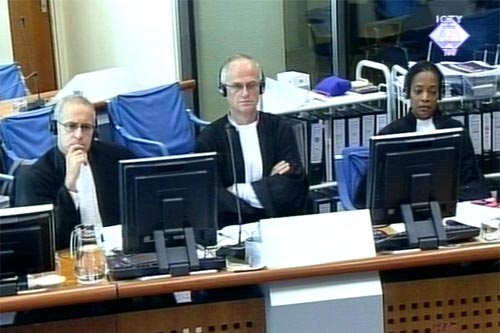Home
DID THE PROSECUTION CONCEAL EXCULPATORY EVIDENCE IN ORIC CASE?
Heated debate on the motion filed by Naser Oric's defense, accusing the prosecution of having concealed the existence of evidence that might exculpate or mitigate the responsibility of the accused
 The prosecution in the Oric trial
The prosecution in the Oric trial Naser Oric's defense accuses the prosecution of having violated Rule 68 of the Rules of Procedure and Evidence, compelling it to "disclose as soon as practicable all materials that might exculpate the accused or mitigate his guilt or affect the credibility of the prosecution evidence".
The defense submitted to the Chamber documents in the possession of the prosecution in which events in the Drina basin are described in a manner playing into the hand of the defense, or so it contents. In one of the documents, a man by the name of Slobodan Misic a/k/a Top describes his "wartime exploits" in the Bratunac area in 1992 and 1993. He says that as a "volunteer from Serbia" he was billeted in Fakovici, on the left bank of the Drina river and that he personally killed between 70 and 80 Muslim civilians – men and women – from an ambush. Those people were foraging for food. Misic estimates that between four and five thousand Muslim civilians were killed in the Drina basin area during the war.
Defense counsel John Jones considers that those arguments corroborate the arguments of the defense that the villages Oric's units attacked, as alleged in the indictment, were not inhabited by civilians but by soldiers or "volunteers" from Serbia, that Muslims moved around searching for food and that even when they were armed they were never under unified command.
The defense claims that the prosecution has had those documents for years, yet that it has failed to disclose them. Prosecutor Gramsci Difazio states that the documents are in the prosecution electronic files and that all defense counsel have access to them – the defense counsel could thus have found them again. The prosecutor also tries to play down the documents' evidentiary value.
Presiding Judge Agius did not like this approach. On several occasions, he took an unusually harsh tone with the prosecution team. "There have been situations again in which the prosecution has made such mistakes, but they have been able to admit to them and say, we are at the Chamber's disposal and we will do all it takes," Agius said, warning the prosecutors that "their defensive attitude might have major consequences". The presiding judge noted that this was a "major omission" causing "great problems for the Chamber" and denying the defense the right to examine the prosecution witnesses on the basis of the new knowledge. The prosecutor then grudgingly admitted that "it seems the prosecution has violated Rule 68".
Since the prosecution is not obliged to disclose documents in the public domain, prosecutor DiFazzio asked for some time to do the necessary checks. Although he did agree to this, the Maltese judge warned the prosecutor to bear in mind "that something published in a Maltese newspaper is not in the public domain".
According to a web search SENSE ran, the confessions of Slobodan Misic a/k/a Top, entitled How I Killed Croats and Muslims was first published on 6 November 1997, not in a Maltese newspaper, but in one published in Vranje – the Vranjske novine. The debate on the omission made by the prosecution is set to continue.
